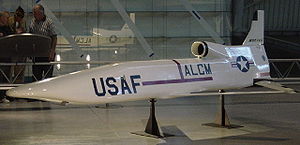AGM-86 ALCM
| AGM-86 | |
|---|---|

An AGM-86A on display at the National Air and Space Museum in 2004.
|
|
| Type | Air-to-ground strategic cruise missile |
| Place of origin | United States |
| Service history | |
| In service | 1982–present |
| Used by | United States Air Force |
| Production history | |
| Designed | 1974 |
| Manufacturer | Boeing Integrated Defense Systems |
| Unit cost | $1 million (AGM-86B) additional $160,000 conversion cost for AGM-86C; additional $896,000 conversion cost for AGM-86D |
| Produced | 1980 |
| Number built | 1,715 (AGM-86B), 239 (AGM-86C), 50 (AGM-86D) |
| Variants | AGM-86B (1982), AGM-86C (1991), AGM-86D (2001) |
| Specifications | |
| Weight | 3,150 pounds (1,430 kg) |
| Length | 20 ft. 9 in. (6.3 m) |
| Diameter | 24.5 inches (62 cm) |
| Warhead |
W80 thermonuclear weapon (AGM-86B) Conventional weapon warhead (AGM-86C) AUP warhead (AGM-86D) |
| Warhead weight | 2,000 lb class (AGM-86C Block 0) 3,000 lb class (AGM-86C Block 1) 1,200 lb class advanced unitary penetrating warhead (AGM-86D) |
|
|
|
| Engine |
Williams International F107-WR-101 Turbofan Engine 600 lbf (2.7 kN) thrust |
| Wingspan | 12 feet (3.7 m) |
|
Operational
range |
AGM-86B: 1,500+ mi (2,400+ km) AGM-86C: classified (nominal 680 miles, 1,100 km) |
| Speed | AGM-86B: 550 mph (890 km/h, Mach 0.73) AGM 86C: classified (nominal high subsonic) |
|
Guidance
system |
AGM-86B: Litton inertial navigation system element with TERCOM updates AGM 86C: Litton INS element integrated with multi-channel onboard GPS |
|
Launch
platform |
Boeing B-52H Stratofortress |
The AGM-86 ALCM is an American subsonic air-launched cruise missile (ALCM) built by Boeing and operated by the United States Air Force. This missile was developed to increase the effectiveness and survivability of the Boeing B-52H Stratofortress bomber. In combination, the missile dilutes an enemy's forces and complicates air defense of its territory.
Examples of the AGM-86A and AGM-86B are on display at the Steven F. Udvar-Hazy Center of the National Air and Space Museum, near Washington, D.C.
The Tor missile system of the Soviet Union was specifically designed from the outset to shoot down the AGM-86.
All variants of the AGM-86 missile are powered by a Williams F107 turbofan jet engine that propels it at sustained subsonic speeds and can be launched from aircraft at both high and low altitudes. The missile deploys its folded wings, tail surfaces and engine inlet after launch.
AGM-86B/C/D missiles increase flexibility in target selection. AGM-86B missiles can be air-launched in large numbers by the bomber force. B-52H bombers carry six AGM-86B or AGM-86C missiles on each of two externally mounted pylons and eight internally on a rotary launcher, giving the B-52H a maximum capacity of 20 missiles per aircraft.
An enemy force would have to counterattack each of the missiles, making defense against them costly and complicated. The enemy's defenses are further hampered by the missiles' small size and low-altitude flight capability, which makes them difficult to detect on radar.
The nuclear armed AGM-86B uses a terrain contour-matching guidance system (TERCOM) to fly to its assigned target.
...
Wikipedia
